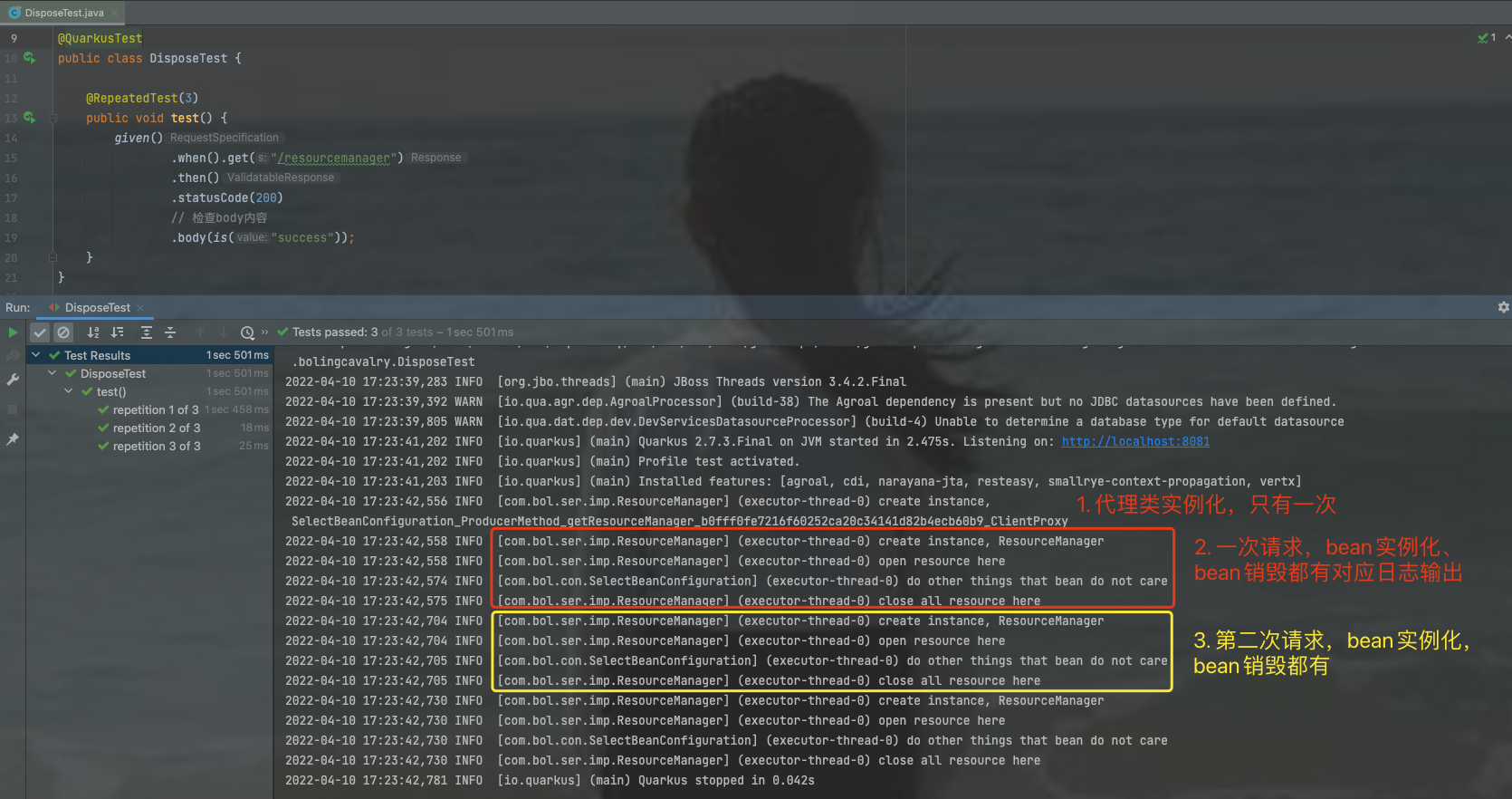这里分类和汇总了欣宸的全部原创(含配套源码):https://github.com/zq2599/blog_demos


package com.bolingcavalry.interceptor.define;
import javax.interceptor.InterceptorBinding;
import java.lang.annotation.ElementType;
import java.lang.annotation.Retention;
import java.lang.annotation.RetentionPolicy;
import java.lang.annotation.Target;
import static java.lang.annotation.ElementType.TYPE;
@InterceptorBinding
@Target({TYPE, ElementType.METHOD})
@Retention(RetentionPolicy.RUNTIME)
public @interface TrackLifeCycle {
}
复制package com.bolingcavalry.interceptor.impl;
import com.bolingcavalry.interceptor.define.TrackLifeCycle;
import io.quarkus.arc.Priority;
import io.quarkus.logging.Log;
import javax.annotation.PostConstruct;
import javax.annotation.PreDestroy;
import javax.interceptor.AroundConstruct;
import javax.interceptor.Interceptor;
import javax.interceptor.InvocationContext;
@TrackLifeCycle
@Interceptor
@Priority(Interceptor.Priority.APPLICATION + 1)
public class LifeCycleInterceptor {
@AroundConstruct
void execute(InvocationContext context) throws Exception {
Log.info("start AroundConstruct");
try {
context.proceed();
} catch (Exception e) {
e.printStackTrace();
}
Log.info("end AroundConstruct");
}
@PostConstruct
public void doPostConstruct(InvocationContext ctx) {
Log.info("life cycle PostConstruct");
}
@PreDestroy
public void doPreDestroy(InvocationContext ctx) {
Log.info("life cycle PreDestroy");
}
}
复制@ApplicationScoped
@TrackLifeCycle
public class Hello {
public Hello() {
Log.info(this.getClass().getSimpleName() + " at instance");
}
public void helloWorld() {
Log.info("Hello world!");
}
}
复制@QuarkusTest
public class LifeCycleTest {
@Inject
Hello hello;
@Test
public void testLifyCycle() {
hello.helloWorld();
}
}
复制15:26:32,447 INFO [io.quarkus] (main) Quarkus 2.7.3.Final on JVM started in 2.899s. Listening on: http://localhost:8081 15:26:32,448 INFO [io.quarkus] (main) Profile test activated. 15:26:32,448 INFO [io.quarkus] (main) Installed features: [agroal, cdi, narayana-jta, resteasy, smallrye-context-propagation, vertx] 15:26:32,483 INFO [com.bol.lif.Hello] (main) Hello_ClientProxy at instance 15:26:33,040 INFO [com.bol.int.imp.LifeCycleInterceptor] (main) start AroundConstruct 15:26:33,040 INFO [com.bol.lif.Hello] (main) Hello_Subclass at instance 15:26:33,040 INFO [com.bol.int.imp.LifeCycleInterceptor] (main) end AroundConstruct 15:26:33,041 INFO [com.bol.int.imp.LifeCycleInterceptor] (main) life cycle PostConstruct 15:26:33,041 INFO [com.bol.lif.Hello] (main) Hello world! 15:26:33,097 INFO [com.bol.int.imp.LifeCycleInterceptor] (main) life cycle PreDestroy 15:26:33,128 INFO [io.quarkus] (main) Quarkus stopped in 0.075s复制
public class CachingMovieLister {
@PostConstruct
public void populateMovieCache() {
// populates the movie cache upon initialization...
}
@PreDestroy
public void clearMovieCache() {
// clears the movie cache upon destruction...
}
}
复制@ApplicationScoped
@TrackLifeCycle
public class Hello {
public Hello() {
Log.info(this.getClass().getSimpleName() + " at instance");
}
@PostConstruct
public void doPostConstruct() {
Log.info("at doPostConstruct");
}
@PreDestroy
public void doPreDestroy() {
Log.info("at PreDestroy");
}
public void helloWorld() {
Log.info("Hello world!");
}
}
复制16:27:54,134 INFO [io.quarkus] (main) Quarkus 2.7.3.Final on JVM started in 2.529s. Listening on: http://localhost:8081
16:27:54,135 INFO [io.quarkus] (main) Profile test activated.
16:27:54,135 INFO [io.quarkus] (main) Installed features: [agroal, cdi, narayana-jta, resteasy, smallrye-context-propagation, vertx]
16:27:54,147 INFO [com.bol.lif.Hello] (main) Hello_ClientProxy at instance
16:27:54,710 INFO [com.bol.int.imp.LifeCycleInterceptor] (main) start AroundConstruct
16:27:54,711 INFO [com.bol.lif.Hello] (main) Hello_Subclass at instance
16:27:54,711 INFO [com.bol.int.imp.LifeCycleInterceptor] (main) end AroundConstruct
16:27:54,711 INFO [com.bol.int.imp.LifeCycleInterceptor] (main) life cycle PostConstruct
16:27:54,712 INFO [com.bol.lif.Hello] (main) at doPostConstruct
16:27:54,712 INFO [com.bol.lif.Hello] (main) Hello world!
16:27:54,747 INFO [com.bol.int.imp.LifeCycleInterceptor] (main) life cycle PreDestroy
16:27:54,747 INFO [com.bol.lif.Hello] (main) at PreDestroy
16:27:54,765 INFO [io.quarkus] (main) Quarkus stopped in 0.044s
复制package com.bolingcavalry.service.impl;
import io.quarkus.logging.Log;
/**
* @author zq2599@gmail.com
* @Title: 资源管理类
* @Package
* @Description:
* @date 4/10/22 10:20 AM
*/
public class ResourceManager {
public ResourceManager () {
Log.info("create instance, " + this.getClass().getSimpleName());
}
/**
* 假设再次方法中打开资源,如网络、文件、数据库等
*/
public void open() {
Log.info("open resource here");
}
/**
* 假设在此方法中关闭所有已打开的资源
*/
public void closeAll() {
Log.info("close all resource here");
}
}
复制package com.bolingcavalry.config;
import com.bolingcavalry.service.impl.ResourceManager;
import javax.enterprise.context.RequestScoped;
public class SelectBeanConfiguration {
@RequestScoped
public ResourceManager getResourceManager() {
return new ResourceManager();
}
}
复制package com.bolingcavalry;
import com.bolingcavalry.service.impl.ResourceManager;
import javax.inject.Inject;
import javax.ws.rs.GET;
import javax.ws.rs.Path;
import javax.ws.rs.Produces;
import javax.ws.rs.core.MediaType;
@Path("/resourcemanager")
public class ResourceManagerController {
@Inject
ResourceManager resourceManager;
@GET
@Produces(MediaType.TEXT_PLAIN)
public String get() {
resourceManager.open();
return "success";
}
}
复制/**
* 使用了Disposes注解后,ResourceManager类型的bean在销毁前,此方法都会执行
* @param resourceManager
*/
public void closeResource(@Disposes ResourceManager resourceManager) {
// 在这里可以做一些额外的操作,不需要bean参与
Log.info("do other things that bean do not care");
// 也可以执行bean的方法
resourceManager.closeAll();
}
复制@QuarkusTest
public class DisposeTest {
@RepeatedTest(3)
public void test() {
given()
.when().get("/resourcemanager")
.then()
.statusCode(200)
// 检查body内容
.body(is("success"));
}
}
复制